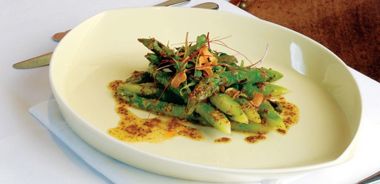Grilled Green Asparagus with Maple Mustard Vinaigrette

Fresh asparagus is the truest sign that spring has sprung. These edible spears have been cultivated throughout the ages by Egyptians, Greeks, and Romans. Rich in dietary fibre, folic acid, and potassium while low in calories and containing no fat or cholesterol, these young shoots are now prepared nearly worldwide in countless ways and an be easily pickled for keeping.
3/4 tsp (4 mL) curry powder
1 Tbsp (15 mL) sea salt
1/4 cup (60 mL) extra-virgin olive oil
30 pieces asparagus spears, medium-sized (bottom inch peeled)
1/4 cup (60 mL) grainy seed mustard
1 Tbsp (15 mL) hot water
1/3 cup (80 mL) maple vinegar (available at fine grocers or substitute sherry vinegar)
1/3 cup (80 mL) extra-virgin olive oil
Salt and white pepper, to taste
Heat barbecue or inside-grill to medium-high heat. Blend curry powder and salt together. Drizzle oil on asparagus, then season with the curry-salt mixture.
Grill asparagus in batches if necessary so as not to crowd the grill and avoid flames. Cook until golden and lightly charred on both sides.
Place mustard in a stainless steel bowl; slowly whisk in hot water and maple vinegar, then slowly whisk in oil. Taste and lightly season with salt and pepper.
Toss asparagus with your favourite salad greens–bitter lettuces work well–and serve with maple mustard vinaigrette.
Serves 6.
source: "Celebrating Spring with Araxi", alive #306, April 2008




